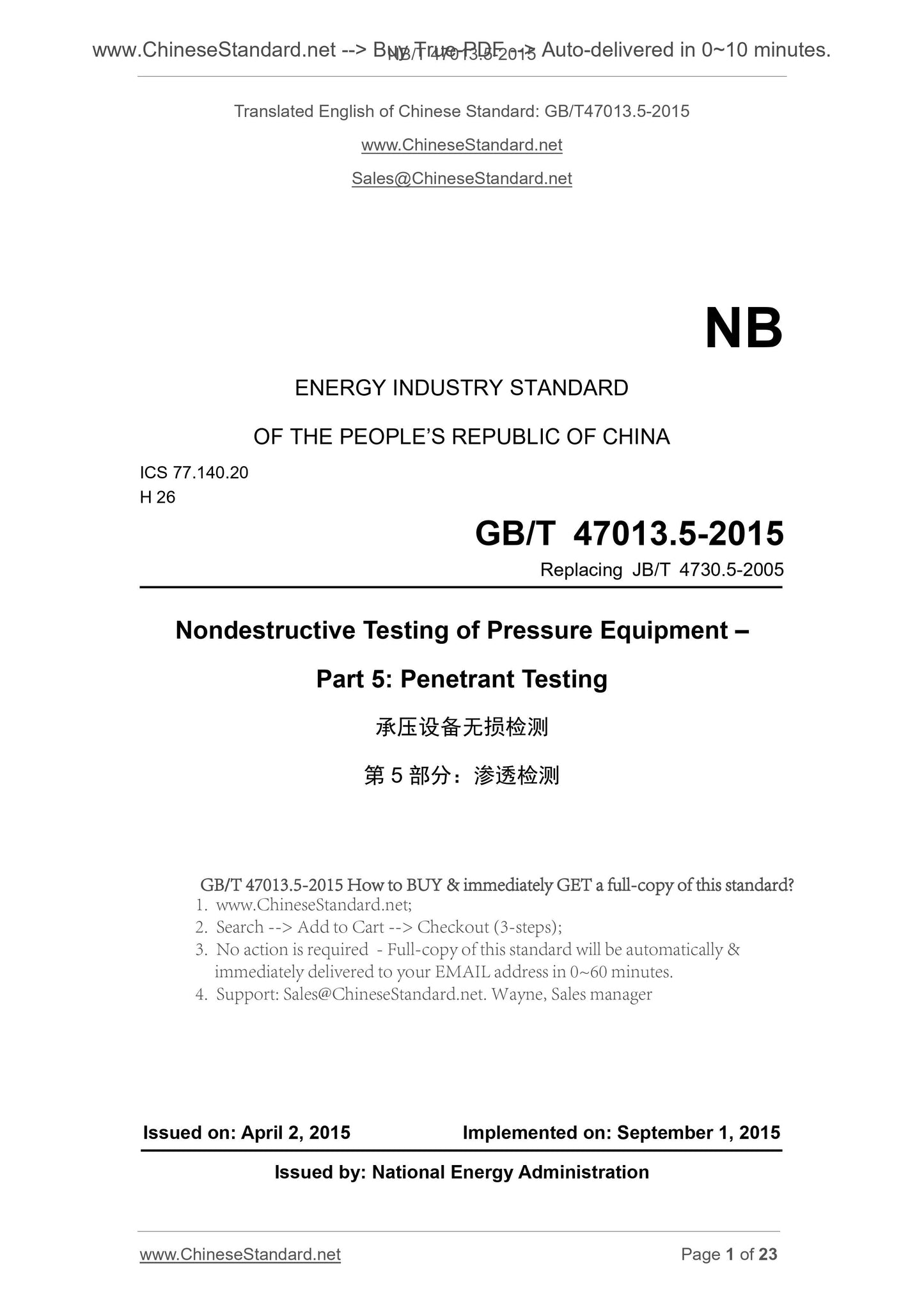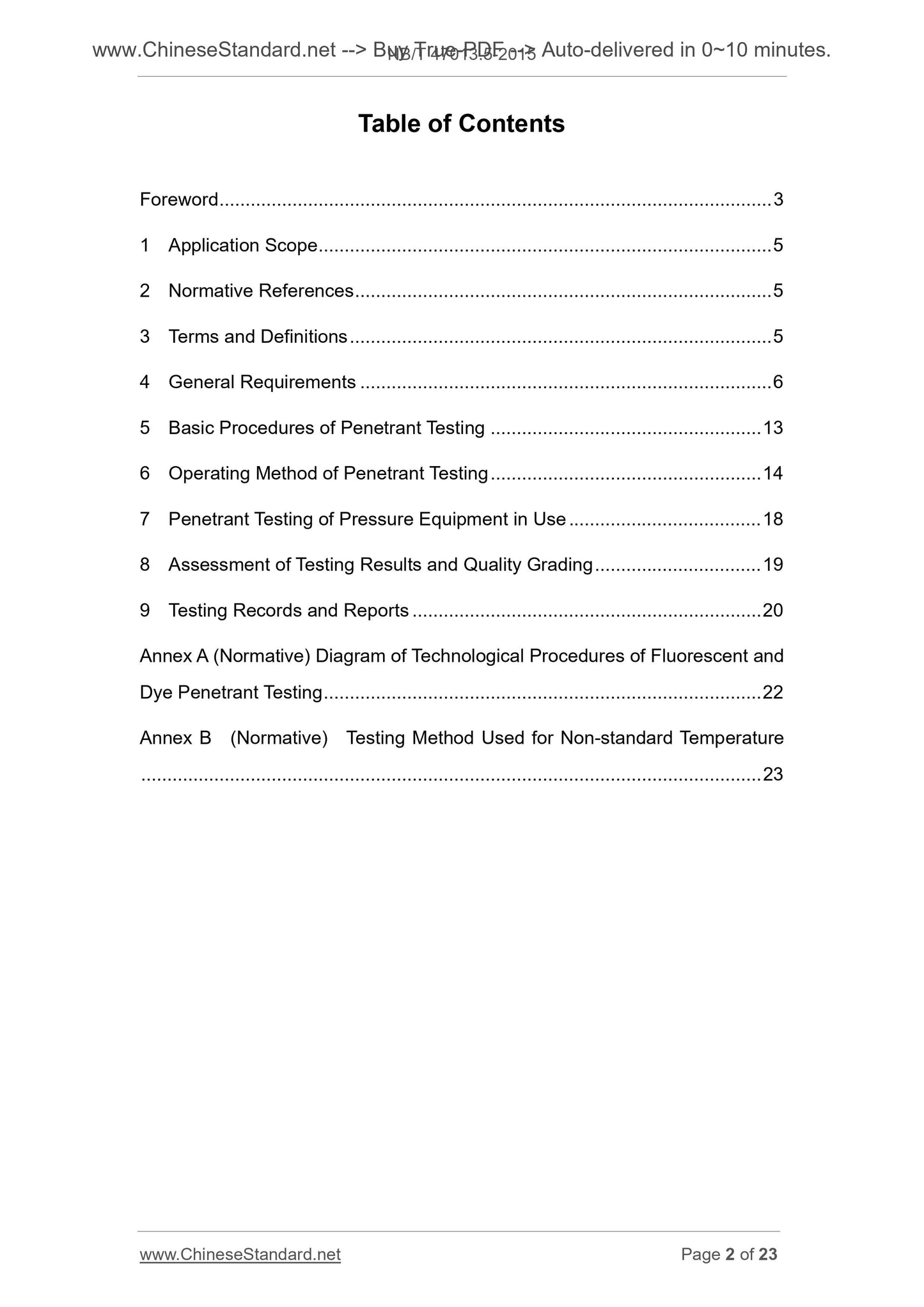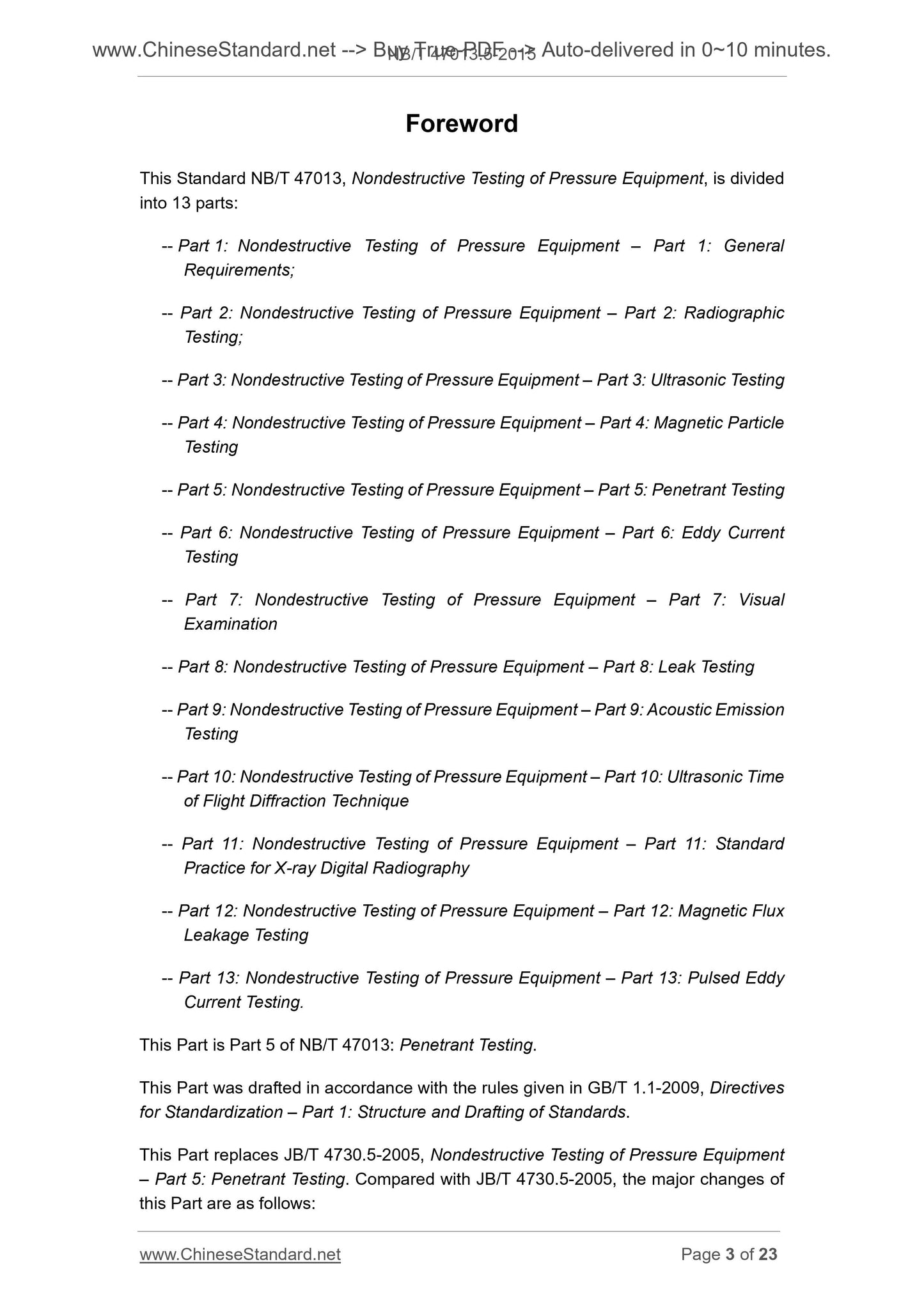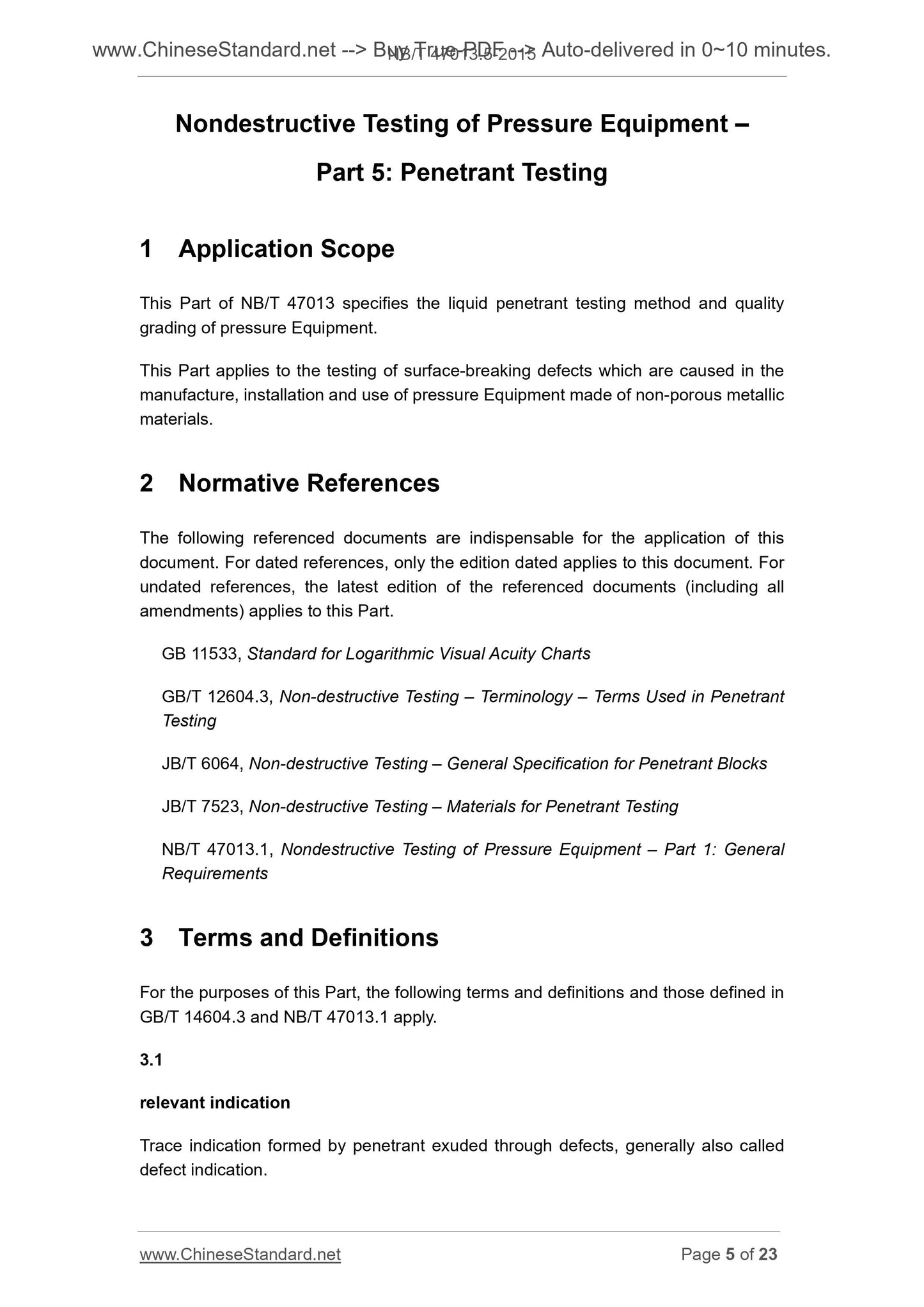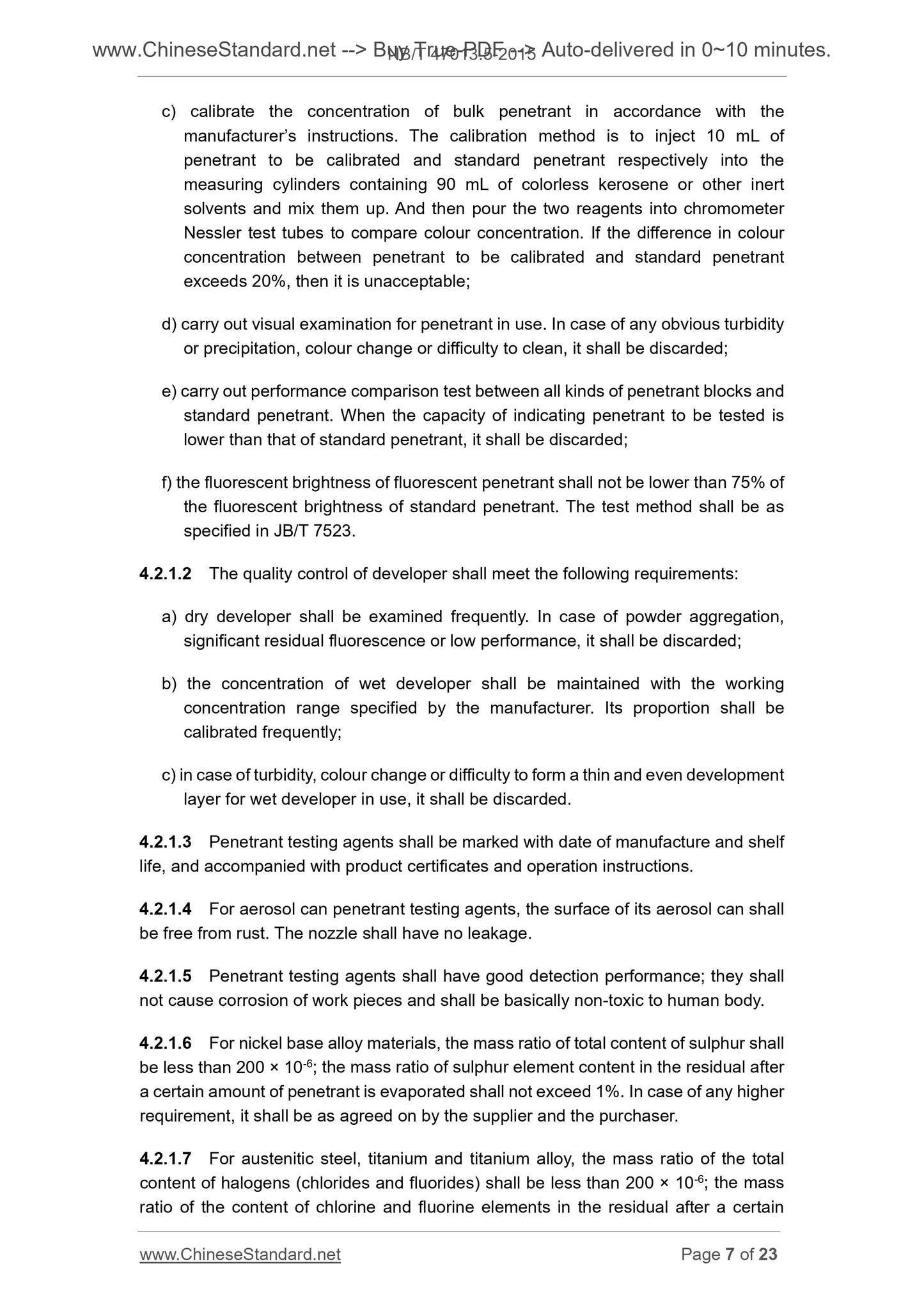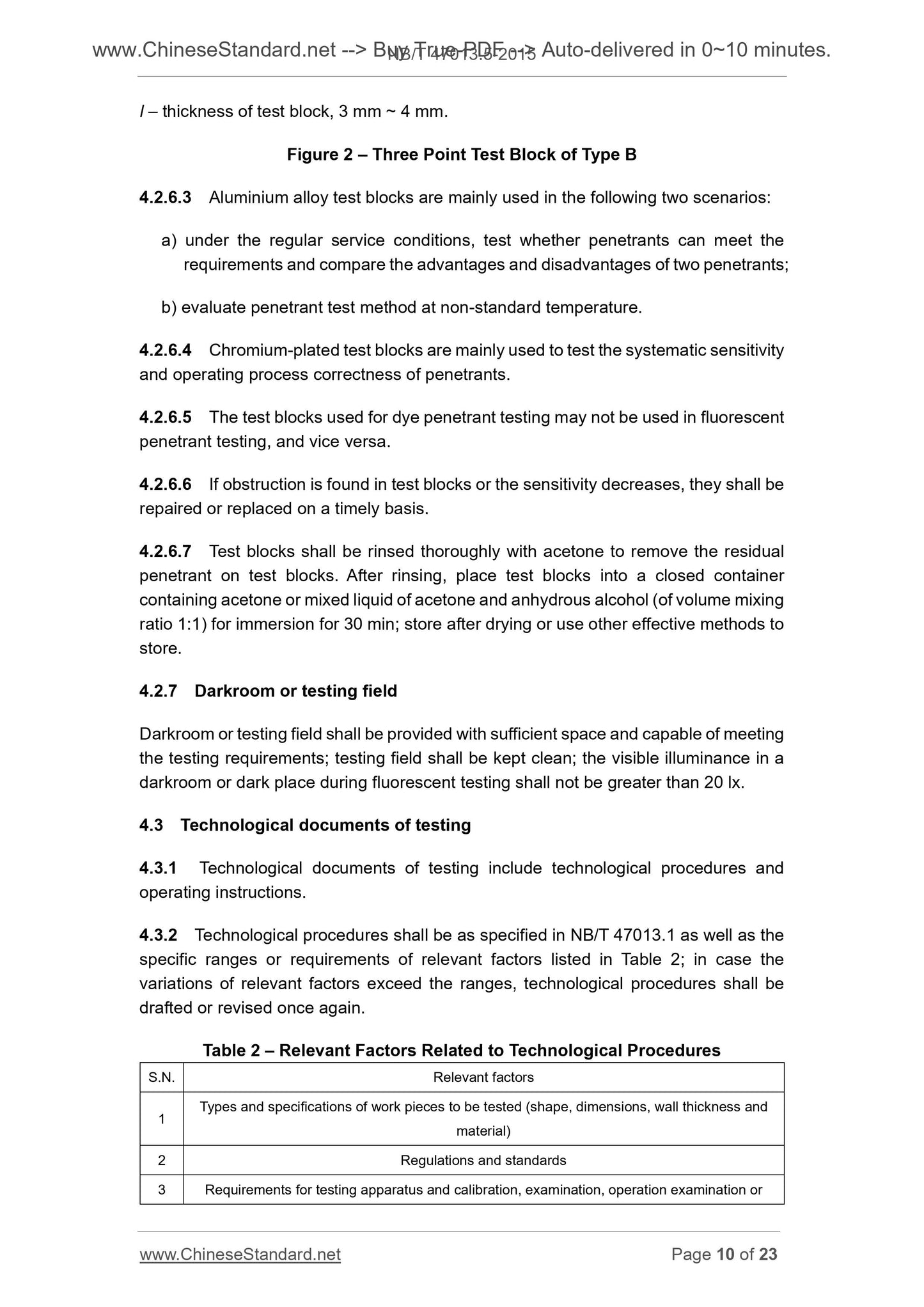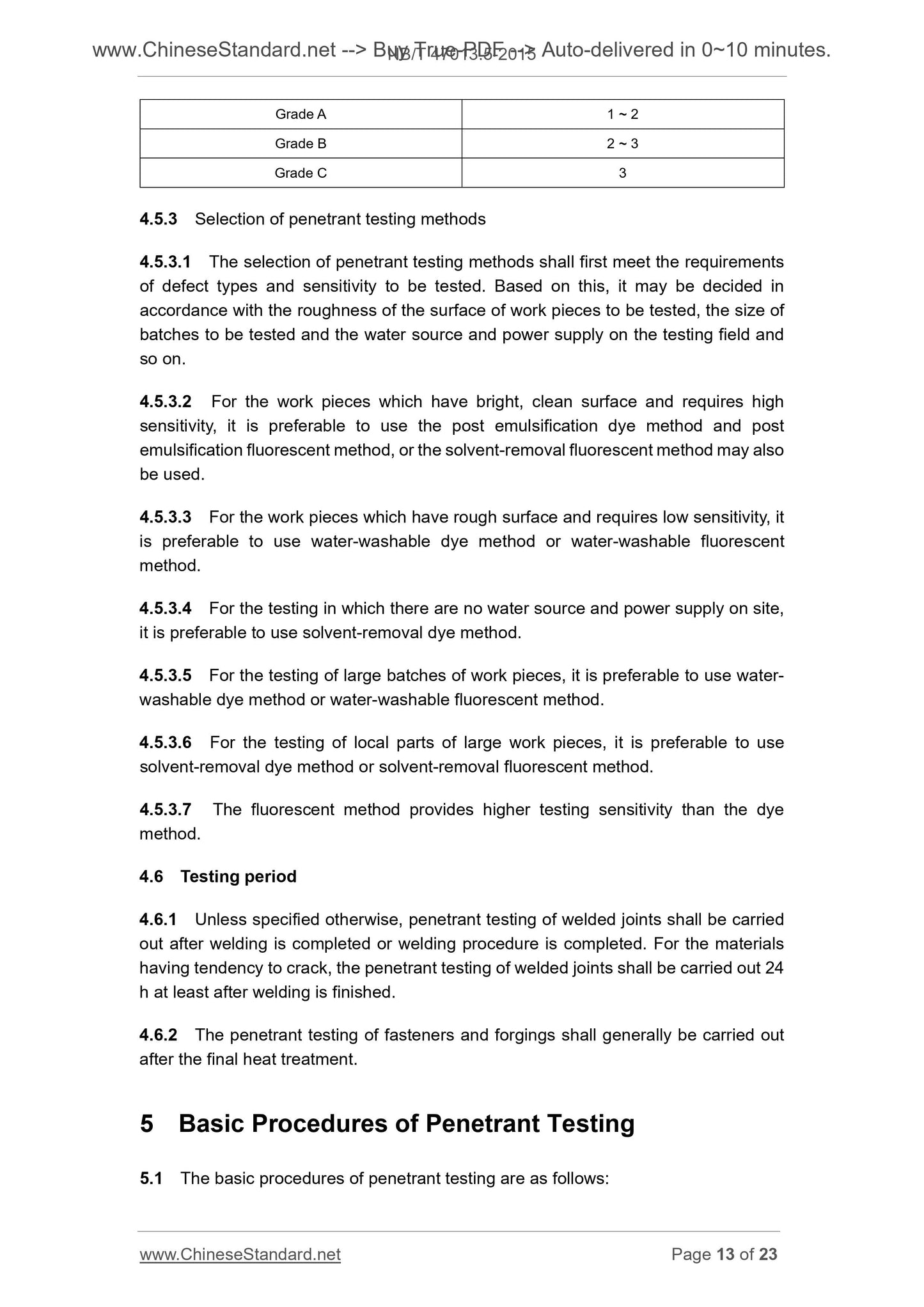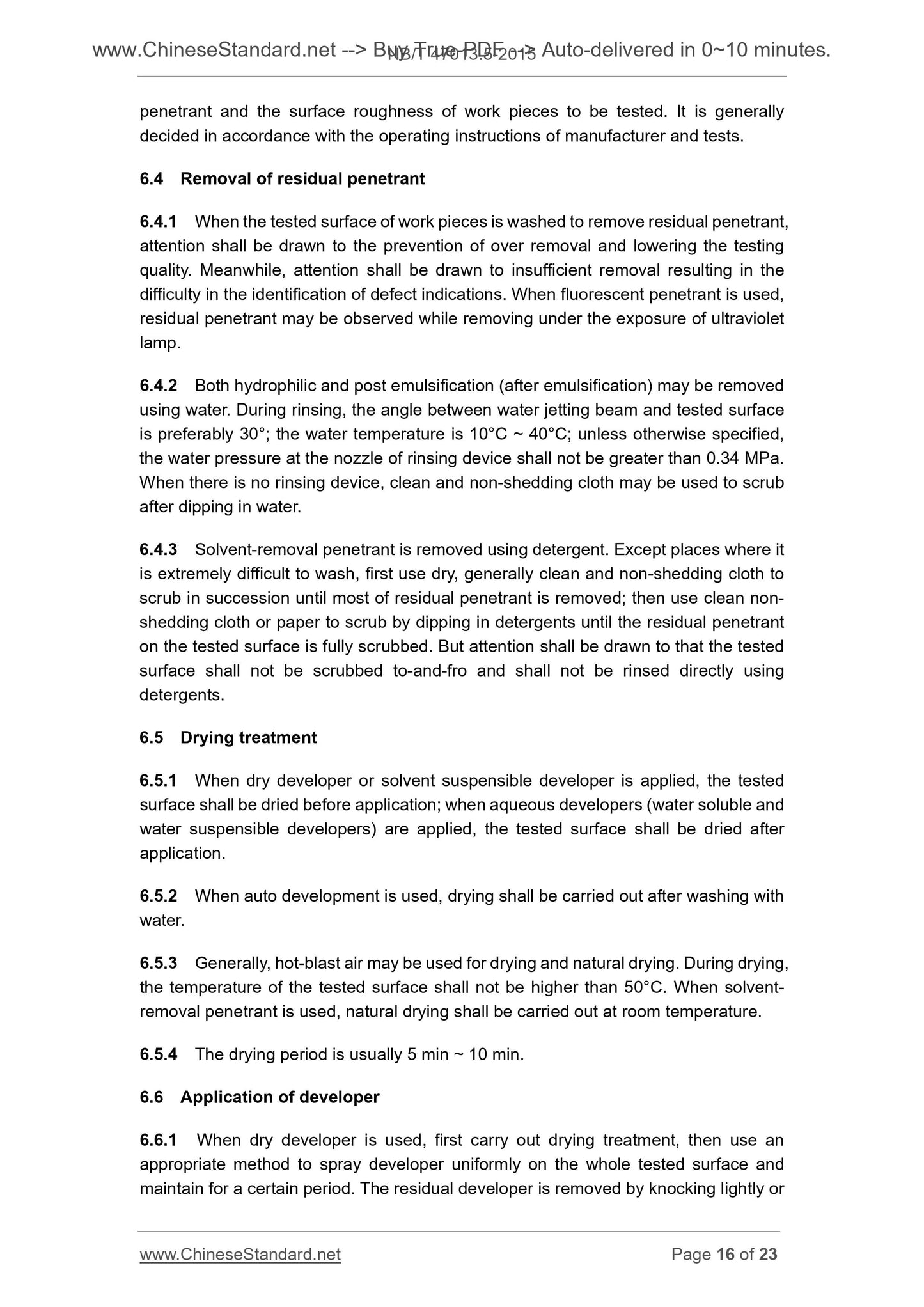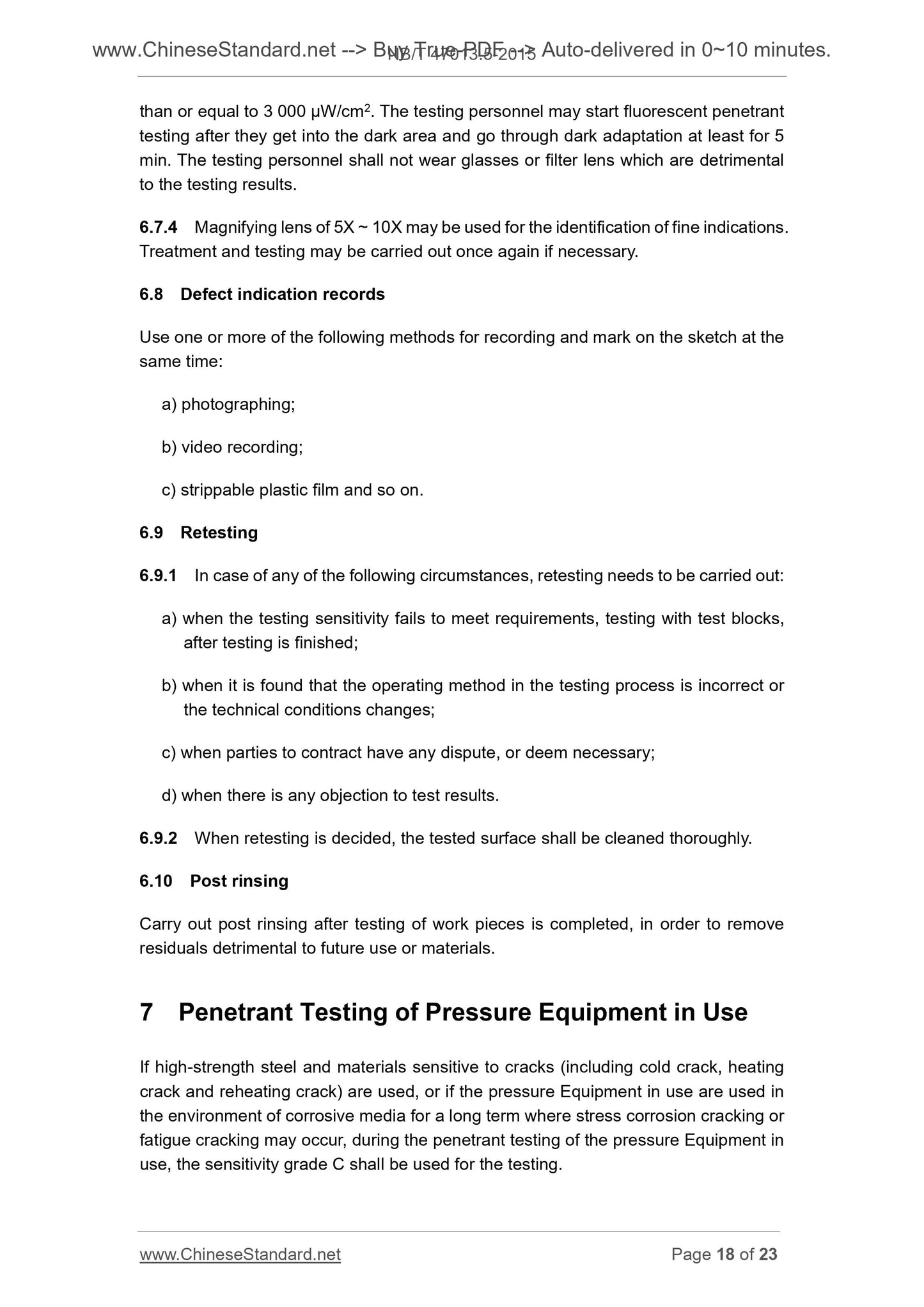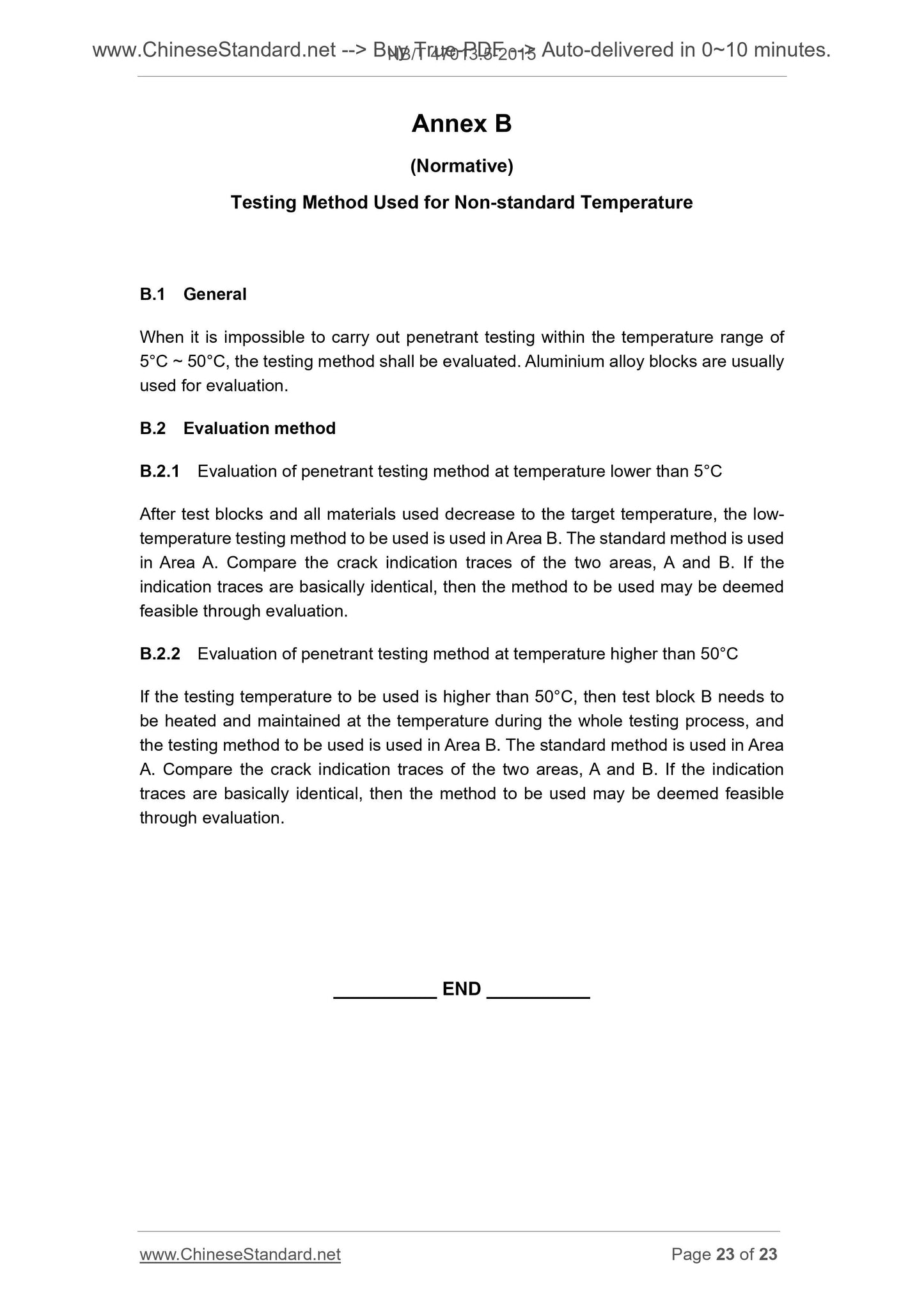1
/
of
10
PayPal, credit cards. Download editable-PDF and invoice in 1 second!
NB/T 47013.5-2015 English PDF (NBT47013.5-2015)
NB/T 47013.5-2015 English PDF (NBT47013.5-2015)
Regular price
$85.00 USD
Regular price
Sale price
$85.00 USD
Unit price
/
per
Shipping calculated at checkout.
Couldn't load pickup availability
Delivery: 3 seconds. Download true-PDF + Invoice.
Get QUOTATION in 1-minute: Click NB/T 47013.5-2015
Historical versions: NB/T 47013.5-2015
Preview True-PDF (Reload/Scroll if blank)
NB/T 47013.5-2015: Nondestructive testing of pressure equipments - Part 5: Penetrant testing
NB/T 47013.5-2015
NB
ENERGY INDUSTRY STANDARD
OF THE PEOPLE’S REPUBLIC OF CHINA
ICS 77.140.20
H 26
GB/T 47013.5-2015
Replacing JB/T 4730.5-2005
Nondestructive Testing of Pressure Equipment –
Part 5. Penetrant Testing
ISSUED ON. APRIL 2, 2015
IMPLEMENTED ON. SEPTEMBER 1, 2015
Issued by. National Energy Administration
3. No action is required - Full-copy of this standard will be automatically and
immediately delivered to your EMAIL address in 0~60 minutes.
Table of Contents
Foreword ... 3
1 Application Scope ... 5
2 Normative References ... 5
3 Terms and Definitions ... 5
4 General Requirements ... 6
5 Basic Procedures of Penetrant Testing ... 13
6 Operating Method of Penetrant Testing ... 14
7 Penetrant Testing of Pressure Equipment in Use ... 18
8 Assessment of Testing Results and Quality Grading ... 19
9 Testing Records and Reports ... 20
Annex A (Normative) Diagram of Technological Procedures of Fluorescent and
Dye Penetrant Testing ... 22
Annex B (Normative) Testing Method Used for Non-standard Temperature
... 23
Foreword
This Standard NB/T 47013, Nondestructive Testing of Pressure Equipment, is divided
into 13 parts.
-- Part 1. Nondestructive Testing of Pressure Equipment – Part 1. General
Requirements;
-- Part 2. Nondestructive Testing of Pressure Equipment – Part 2. Radiographic
Testing;
-- Part 3. Nondestructive Testing of Pressure Equipment – Part 3. Ultrasonic Testing
-- Part 4. Nondestructive Testing of Pressure Equipment – Part 4. Magnetic Particle
Testing
-- Part 5. Nondestructive Testing of Pressure Equipment – Part 5. Penetrant Testing
-- Part 6. Nondestructive Testing of Pressure Equipment – Part 6. Eddy Current
Testing
-- Part 7. Nondestructive Testing of Pressure Equipment – Part 7. Visual
Examination
-- Part 8. Nondestructive Testing of Pressure Equipment – Part 8. Leak Testing
-- Part 9. Nondestructive Testing of Pressure Equipment – Part 9. Acoustic Emission
Testing
-- Part 10. Nondestructive Testing of Pressure Equipment – Part 10. Ultrasonic Time
of Flight Diffraction Technique
-- Part 11. Nondestructive Testing of Pressure Equipment – Part 11. Standard
Practice for X-ray Digital Radiography
-- Part 12. Nondestructive Testing of Pressure Equipment – Part 12. Magnetic Flux
Leakage Testing
-- Part 13. Nondestructive Testing of Pressure Equipment – Part 13. Pulsed Eddy
Current Testing.
This Part is Part 5 of NB/T 47013. Penetrant Testing.
This Part was drafted in accordance with the rules given in GB/T 1.1-2009, Directives
for Standardization – Part 1. Structure and Drafting of Standards.
This Part replaces JB/T 4730.5-2005, Nondestructive Testing of Pressure Equipment
– Part 5. Penetrant Testing. Compared with JB/T 4730.5-2005, the major changes of
this Part are as follows.
Nondestructive Testing of Pressure Equipment –
Part 5. Penetrant Testing
1 Application Scope
This Part of NB/T 47013 specifies the liquid penetrant testing method and quality
grading of pressure Equipment.
This Part applies to the testing of surface-breaking defects which are caused in the
manufacture, installation and use of pressure Equipment made of non-porous metallic
materials.
2 Normative References
The following referenced documents are indispensable for the application of this
document. For dated references, only the edition dated applies to this document. For
undated references, the latest edition of the referenced documents (including all
amendments) applies to this Part.
GB 11533, Standard for Logarithmic Visual Acuity Charts
GB/T 12604.3, Non-destructive Testing – Terminology – Terms Used in Penetrant
Testing
JB/T 6064, Non-destructive Testing – General Specification for Penetrant Blocks
JB/T 7523, Non-destructive Testing – Materials for Penetrant Testing
NB/T 47013.1, Nondestructive Testing of Pressure Equipment – Part 1. General
Requirements
3 Terms and Definitions
For the purposes of this Part, the following terms and definitions and those defined in
GB/T 14604.3 and NB/T 47013.1 apply.
3.1
relevant indication
Trace indication formed by penetrant exuded through defects, generally also called
defect indication.
c) calibrate the concentration of bulk penetrant in accordance with the
manufacturer’s instructions. The calibration method is to inject 10 mL of
penetrant to be calibrated and standard penetrant respectively into the
measuring cylinders containing 90 mL of colorless kerosene or other inert
solvents and mix them up. And then pour the two reagents into chromometer
Nessler test tubes to compare colour concentration. If the difference in colour
concentration between penetrant to be calibrated and standard penetrant
exceeds 20%, then it is unacceptable;
d) carry out visual examination for penetrant in use. In case of any obvious turbidity
or precipitation, colour change or difficulty to clean, it shall be discarded;
e) carry out performance comparison test between all kinds of penetrant blocks and
standard penetrant. When the capacity of indicating penetrant to be tested is
lower than that of standard penetrant, it shall be discarded;
f) the fluorescent brightness of fluorescent penetrant shall not be lower than 75% of
the fluorescent brightness of standard penetrant. The test method shall be as
specified in JB/T 7523.
4.2.1.2 The quality control of developer shall meet the following requirements.
a) dry developer shall be examined frequently. In case of powder aggregation,
significant residual fluorescence or low performance, it shall be discarded;
b) the concentration of wet developer shall be maintained with the working
concentration range specified by the manufacturer. Its proportion shall be
calibrated frequently;
c) in case of turbidity, colour change or difficulty to form a thin and even development
layer for wet developer in use, it shall be discarded.
4.2.1.3 Penetrant testing agents shall be marked with date of manufacture and shelf
life, and accompanied with product certificates and operation instructions.
4.2.1.4 For aerosol can penetrant testing agents, the surface of its aerosol can shall
be free from rust. The nozzle shall have no leakage.
4.2.1.5 Penetrant testing agents shall have good detection performance; they shall
not cause corrosion of work pieces and shall be basically non-toxic to human body.
4.2.1.6 For nickel base alloy materials, the mass ratio of total content of sulphur shall
be less than 200 × 10-6; the mass ratio of sulphur element content in the residual after
a certain amount of penetrant is evaporated shall not exceed 1%. In case of any higher
requirement, it shall be as agreed on by the supplier and the purchaser.
4.2.1.7 For austenitic steel, titanium and titanium alloy, the mass ratio of the total
content of halogens (chlorides and fluorides) shall be less than 200 × 10-6; the mass
ratio of the content of chlorine and fluorine elements in the residual after a certain
l – thickness of test block, 3 mm ~ 4 mm.
Figure 2 – Three Point Test Block of Type B
4.2.6.3 Aluminium alloy test blocks are mainly used in the following two scenarios.
a) under the regular service conditions, test whether penetrants can meet the
requirements and compare the advantages and disadvantages of two penetrants;
b) evaluate penetrant test method at non-standard temperature.
4.2.6.4 Chromium-plated test blocks are mainly used to test the systematic sensitivity
and operat...
Get QUOTATION in 1-minute: Click NB/T 47013.5-2015
Historical versions: NB/T 47013.5-2015
Preview True-PDF (Reload/Scroll if blank)
NB/T 47013.5-2015: Nondestructive testing of pressure equipments - Part 5: Penetrant testing
NB/T 47013.5-2015
NB
ENERGY INDUSTRY STANDARD
OF THE PEOPLE’S REPUBLIC OF CHINA
ICS 77.140.20
H 26
GB/T 47013.5-2015
Replacing JB/T 4730.5-2005
Nondestructive Testing of Pressure Equipment –
Part 5. Penetrant Testing
ISSUED ON. APRIL 2, 2015
IMPLEMENTED ON. SEPTEMBER 1, 2015
Issued by. National Energy Administration
3. No action is required - Full-copy of this standard will be automatically and
immediately delivered to your EMAIL address in 0~60 minutes.
Table of Contents
Foreword ... 3
1 Application Scope ... 5
2 Normative References ... 5
3 Terms and Definitions ... 5
4 General Requirements ... 6
5 Basic Procedures of Penetrant Testing ... 13
6 Operating Method of Penetrant Testing ... 14
7 Penetrant Testing of Pressure Equipment in Use ... 18
8 Assessment of Testing Results and Quality Grading ... 19
9 Testing Records and Reports ... 20
Annex A (Normative) Diagram of Technological Procedures of Fluorescent and
Dye Penetrant Testing ... 22
Annex B (Normative) Testing Method Used for Non-standard Temperature
... 23
Foreword
This Standard NB/T 47013, Nondestructive Testing of Pressure Equipment, is divided
into 13 parts.
-- Part 1. Nondestructive Testing of Pressure Equipment – Part 1. General
Requirements;
-- Part 2. Nondestructive Testing of Pressure Equipment – Part 2. Radiographic
Testing;
-- Part 3. Nondestructive Testing of Pressure Equipment – Part 3. Ultrasonic Testing
-- Part 4. Nondestructive Testing of Pressure Equipment – Part 4. Magnetic Particle
Testing
-- Part 5. Nondestructive Testing of Pressure Equipment – Part 5. Penetrant Testing
-- Part 6. Nondestructive Testing of Pressure Equipment – Part 6. Eddy Current
Testing
-- Part 7. Nondestructive Testing of Pressure Equipment – Part 7. Visual
Examination
-- Part 8. Nondestructive Testing of Pressure Equipment – Part 8. Leak Testing
-- Part 9. Nondestructive Testing of Pressure Equipment – Part 9. Acoustic Emission
Testing
-- Part 10. Nondestructive Testing of Pressure Equipment – Part 10. Ultrasonic Time
of Flight Diffraction Technique
-- Part 11. Nondestructive Testing of Pressure Equipment – Part 11. Standard
Practice for X-ray Digital Radiography
-- Part 12. Nondestructive Testing of Pressure Equipment – Part 12. Magnetic Flux
Leakage Testing
-- Part 13. Nondestructive Testing of Pressure Equipment – Part 13. Pulsed Eddy
Current Testing.
This Part is Part 5 of NB/T 47013. Penetrant Testing.
This Part was drafted in accordance with the rules given in GB/T 1.1-2009, Directives
for Standardization – Part 1. Structure and Drafting of Standards.
This Part replaces JB/T 4730.5-2005, Nondestructive Testing of Pressure Equipment
– Part 5. Penetrant Testing. Compared with JB/T 4730.5-2005, the major changes of
this Part are as follows.
Nondestructive Testing of Pressure Equipment –
Part 5. Penetrant Testing
1 Application Scope
This Part of NB/T 47013 specifies the liquid penetrant testing method and quality
grading of pressure Equipment.
This Part applies to the testing of surface-breaking defects which are caused in the
manufacture, installation and use of pressure Equipment made of non-porous metallic
materials.
2 Normative References
The following referenced documents are indispensable for the application of this
document. For dated references, only the edition dated applies to this document. For
undated references, the latest edition of the referenced documents (including all
amendments) applies to this Part.
GB 11533, Standard for Logarithmic Visual Acuity Charts
GB/T 12604.3, Non-destructive Testing – Terminology – Terms Used in Penetrant
Testing
JB/T 6064, Non-destructive Testing – General Specification for Penetrant Blocks
JB/T 7523, Non-destructive Testing – Materials for Penetrant Testing
NB/T 47013.1, Nondestructive Testing of Pressure Equipment – Part 1. General
Requirements
3 Terms and Definitions
For the purposes of this Part, the following terms and definitions and those defined in
GB/T 14604.3 and NB/T 47013.1 apply.
3.1
relevant indication
Trace indication formed by penetrant exuded through defects, generally also called
defect indication.
c) calibrate the concentration of bulk penetrant in accordance with the
manufacturer’s instructions. The calibration method is to inject 10 mL of
penetrant to be calibrated and standard penetrant respectively into the
measuring cylinders containing 90 mL of colorless kerosene or other inert
solvents and mix them up. And then pour the two reagents into chromometer
Nessler test tubes to compare colour concentration. If the difference in colour
concentration between penetrant to be calibrated and standard penetrant
exceeds 20%, then it is unacceptable;
d) carry out visual examination for penetrant in use. In case of any obvious turbidity
or precipitation, colour change or difficulty to clean, it shall be discarded;
e) carry out performance comparison test between all kinds of penetrant blocks and
standard penetrant. When the capacity of indicating penetrant to be tested is
lower than that of standard penetrant, it shall be discarded;
f) the fluorescent brightness of fluorescent penetrant shall not be lower than 75% of
the fluorescent brightness of standard penetrant. The test method shall be as
specified in JB/T 7523.
4.2.1.2 The quality control of developer shall meet the following requirements.
a) dry developer shall be examined frequently. In case of powder aggregation,
significant residual fluorescence or low performance, it shall be discarded;
b) the concentration of wet developer shall be maintained with the working
concentration range specified by the manufacturer. Its proportion shall be
calibrated frequently;
c) in case of turbidity, colour change or difficulty to form a thin and even development
layer for wet developer in use, it shall be discarded.
4.2.1.3 Penetrant testing agents shall be marked with date of manufacture and shelf
life, and accompanied with product certificates and operation instructions.
4.2.1.4 For aerosol can penetrant testing agents, the surface of its aerosol can shall
be free from rust. The nozzle shall have no leakage.
4.2.1.5 Penetrant testing agents shall have good detection performance; they shall
not cause corrosion of work pieces and shall be basically non-toxic to human body.
4.2.1.6 For nickel base alloy materials, the mass ratio of total content of sulphur shall
be less than 200 × 10-6; the mass ratio of sulphur element content in the residual after
a certain amount of penetrant is evaporated shall not exceed 1%. In case of any higher
requirement, it shall be as agreed on by the supplier and the purchaser.
4.2.1.7 For austenitic steel, titanium and titanium alloy, the mass ratio of the total
content of halogens (chlorides and fluorides) shall be less than 200 × 10-6; the mass
ratio of the content of chlorine and fluorine elements in the residual after a certain
l – thickness of test block, 3 mm ~ 4 mm.
Figure 2 – Three Point Test Block of Type B
4.2.6.3 Aluminium alloy test blocks are mainly used in the following two scenarios.
a) under the regular service conditions, test whether penetrants can meet the
requirements and compare the advantages and disadvantages of two penetrants;
b) evaluate penetrant test method at non-standard temperature.
4.2.6.4 Chromium-plated test blocks are mainly used to test the systematic sensitivity
and operat...
Share
